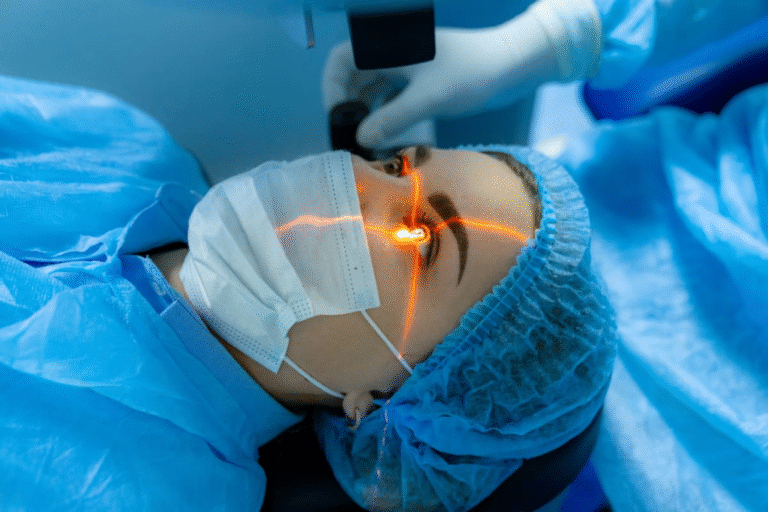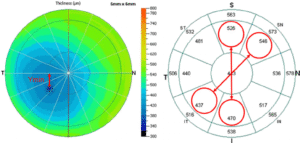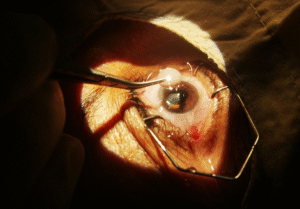Laser cataract surgery: Is it worth the upgrade?

Cataracts are a common eye condition, especially in older adults, that cause clouding of the natural lens in the eye, leading to blurry vision and eventual vision loss if untreated. Cataract surgery has long been one of the most successful and widely performed procedures in the world. Today, with advancements in ophthalmology, laser-assisted cataract surgery has emerged as a promising alternative to traditional techniques. But is it worth the upgrade?
Choosing the right cataract surgery option can be overwhelming. This blog will help you understand how laser cataract surgery differs from traditional methods and whether it may be the right choice for your needs.
Table of Contents
ToggleWhat is laser cataract surgery?
Laser cataract surgery, also known as femtosecond laser-assisted cataract surgery (FLACS), uses a highly precise laser to perform some of the key steps in cataract removal. Unlike traditional surgery that relies on handheld blades, this technique uses a computer-guided laser to increase precision and potentially improve surgical outcomes.
Advantages of laser cataract surgery
1. Greater precision
The femtosecond laser used in cataract surgery creates incisions that are more accurate, consistent, and predictable than those made manually. This high level of precision minimizes the risk of complications such as irregular wound healing or imperfect capsulotomy (opening of the lens capsule). As a result, patients benefit from safer surgery and more stable outcomes.
Advantages:
- Reduces human error and surgical variability.
- Ensures better placement and centration of the intraocular lens (IOL).
- Enhances the safety of the procedure, especially in complex cases.
2. Improved visual outcomes
The laser helps achieve exact positioning of the IOL and allows surgeons to correct mild astigmatism during the same procedure. This increases the chances of achieving clearer, more focused vision without glasses after surgery.
Advantages:
- Higher likelihood of achieving 20/20 or near-perfect vision.
- Reduces dependency on spectacles or contact lenses.
- Enhances satisfaction, particularly for patients opting for premium IOLs like multifocal or toric lenses.
3. Less energy, Less trauma
The laser softens the cataract before it is removed, which means less ultrasound energy is required during phacoemulsification. Lower energy levels lead to reduced trauma to the surrounding eye tissues, particularly the corneal endothelium.
Advantages:
- Decreased inflammation and swelling post-surgery.
- Faster recovery and visual rehabilitation.
- Safer for patients with sensitive or compromised eyes (e.g., pre-existing corneal conditions)
4. Customized treatment
Laser-assisted cataract surgery uses advanced imaging technology such as Optical Coherence Tomography (OCT) to map the eye’s structures in real time. This allows the surgeon to plan and execute a procedure tailored to each patient’s unique eye anatomy.
Advantages:
- Personalized surgery ensures better lens alignment and placement
- Improves the precision of incisions and capsulotomy for optimal results
- Reduces variability between patients and enhances consistency in surgical success
Are there any disadvantages?
While laser cataract surgery offers advanced benefits, it’s important to weigh the potential downsides:
- Higher cost: This procedure is typically more expensive than conventional surgery and may not be fully covered by insurance.
- Not for every case: Some patients with specific eye conditions may not be eligible for laser-assisted surgery.
- Similar safety profile: While more precise, studies show that laser surgery and traditional methods have comparable success and safety rates.
Who should consider laser cataract surgery?
You might be a good candidate for laser cataract surgery if:
- You want enhanced precision and predictability.
- You have astigmatism and want it corrected during surgery.
- You are opting for premium intraocular lenses (IOLs) for better visual quality.
- You want to reduce your dependency on glasses after surgery.
What happens during the procedure?
The laser cataract surgery procedure typically involves the following steps:
1. Pre-surgical imaging to map your eye precisely

Before the surgery begins, a high-resolution 3D image of your eye is taken using Optical Coherence Tomography (OCT). This scan provides detailed information about the shape, size, and thickness of your cornea and lens. The surgeon uses this data to create a customized surgical plan tailored specifically to your eye, ensuring maximum precision and safety.
2. Laser application to make incisions and Soften the cataract
Using a femtosecond laser, the surgeon makes tiny, precise incisions in the cornea to access the lens. The laser also creates a circular opening in the lens capsule (called a capsulotomy) and gently softens the cataract, breaking it into smaller, more manageable pieces. This step reduces the need for excessive ultrasound energy during the next phase.
3. Ultrasound and Suction to remove the lens

Once the cataract has been softened, an ultrasound probe (phacoemulsification) is inserted through the incision. It breaks the lens into fine fragments, which are then gently suctioned out of the eye. Because the laser has already softened the cataract, this step is quicker and less traumatic to the surrounding tissues.
4. Insertion of Intraocular Lens (IOL) with exact positioning
After the natural cloudy lens is removed, a foldable artificial lens (IOL) is inserted through the same small incision. The surgeon positions the lens precisely within the eye, often using laser guidance for enhanced accuracy. The choice of IOL can vary—monofocal, multifocal, or toric—based on your visual needs.
5. Post-surgical monitoring and Guidance for a smooth recovery
Once the surgery is complete, your eye will be monitored for a short period to ensure there are no immediate complications. You’ll be sent home with detailed post-operative instructions, including prescribed eye drops to prevent infection and reduce inflammation. Follow-up visits are scheduled to track healing and ensure optimal vision recovery.
The procedure is quick, usually completed in under 30 minutes, and performed under local anesthesia.
Post-Surgery recovery and Care
Recovery after laser cataract surgery is generally smooth, with most patients experiencing minimal discomfort and a rapid return to normal activities. Here’s what to expect:
1. Quick vision improvement
Many patients begin to notice clearer vision within 24 to 48 hours after surgery. While initial recovery is fast, it may take a few days to weeks for your vision to fully stabilize, especially if both eyes are treated separately or if you’ve opted for advanced IOLs like multifocal or toric lenses.
2. Use of prescribed eye drops
You’ll be prescribed a course of antibiotics, anti-inflammatory, and lubricating eye drops, which you’ll need to use for several weeks. These drops help prevent infection, reduce swelling, and promote smooth healing. It’s important to follow the dosage instructions carefully for best results.
3. Activity restrictions
To ensure proper healing, certain precautions are necessary:
- Avoid heavy lifting, bending over, or any strenuous activity for at least a week.
- Stay away from dusty or dirty environments to reduce the risk of infection.
- Do not rub your eyes, and avoid water getting into the eyes while bathing.
4. Follow-Up appointments
Regular check-ups with your ophthalmologist are essential to monitor your healing progress. Typically, the first visit is scheduled within 1–2 days after surgery, followed by additional visits over the next few weeks. During these appointments, your eye pressure, healing, and vision are evaluated.
With proper care, most patients achieve excellent visual outcomes and return to daily activities quickly. Laser-assisted cataract surgery often leads to faster recovery compared to traditional methods due to its precision and minimal tissue trauma.
Final verdict: Is it worth the upgrade?
Laser cataract surgery offers a modern, blade-free approach with high precision and customizability. For patients seeking premium outcomes, especially those choosing advanced IOLs or looking to correct astigmatism, it can be a worthwhile upgrade.
However, both traditional and laser surgeries are safe and effective. The best choice depends on your individual eye condition, visual goals, and budget.
Our experienced cataract doctor in Ahmedabad at Krisha Eye Hospital will assess your case and help you decide the most suitable option.
Conclusion
Laser cataract surgery offers enhanced precision, faster recovery, and better visual outcomes—making it a valuable option for many patients. While both traditional and laser methods are effective, the right choice depends on your individual needs and goals.
At Krisha Eye Hospital in Ahmedabad, our skilled cataract surgeons use advanced technology and personalized care to help you achieve the best possible results.
Book your consultation today and take the first step toward clearer vision.
Author bio
Dr. Dhwani Maheshwari, an esteemed ophthalmologist with over 10 years of experience, leads Krisha Eye hospital in Ahmedabad with a commitment to advanced, patient-centered eye care. Specializing in cataract and refractive surgery, Dr. Maheshwari has performed more than a thousand successful surgeries. Her expertise lies in phacoemulsification, a technique recognized for its precision in cataract treatment.
Dr. Maheshwari’s educational journey includes an MBBS from Smt. NHL MMC, a DOMS from M & J Institute of Ophthalmology, and a DNB in Ophthalmology from Mahatme Eye Bank Eye Hospital, Nagpur. She also completed a fellowship in phacoemulsification at Porecha Blindness Trust Hospital, further enhancing her surgical skills. In addition to her work at Krisha Eye Hospital, Dr. Maheshwari serves as a consultant ophthalmologist at Northstar Diagnostic Centre.
Under her leadership, Krisha Eye Hospital aims to bring all super specialties under one roof, offering comprehensive eye care solutions for all vision needs.
FAQs
The results are usually permanent. Once the cataract is removed and replaced with an intraocular lens, it does not return. However, some patients may develop a condition called posterior capsular opacification (PCO), which can be treated with a quick laser procedure.
Laser cataract surgery is typically painless. Most patients only feel mild pressure during the procedure, as it is performed under local anesthesia with numbing eye drops.
It is standard practice to treat one eye at a time. The second eye is usually operated on after the first eye has healed, typically within a few weeks.
Most patients can resume light activities such as reading or watching TV within a day. However, activities like swimming, heavy lifting, or driving should be avoided for several days or as advised by your surgeon.
While rare, complications can include infection, inflammation, increased eye pressure, or lens dislocation. These are similar to risks associated with traditional surgery but are often minimized with laser precision.
Local anesthesia is used, typically in the form of numbing eye drops. Patients remain awake during the procedure but feel no pain.
Yes, patients can choose from various types of IOLs, including monofocal, multifocal, and toric lenses, depending on their visual needs and eye condition.
Laser cataract surgery usually costs more than traditional surgery due to the advanced technology used and the added benefits it offers. Costs can also vary depending on the type of IOL selected.
